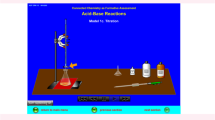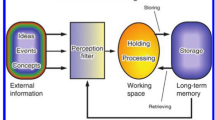Abstract
Chemistry curriculum should account for learning in context and understanding chemistry at the macroscopic and microscopic levels: the symbol level and the process level. The Taste of Chemistry learning module, developed for high school chemistry majors (students who choose to study the advanced chemistry program in high school), focuses on food-related chemistry, emphasizes learning in context and chemical understanding, and promotes the use of graphing skills. While learning, students are exposed to metacognitive prompts related to the four chemistry-understanding levels and to graphing skills. The objectives were to investigate (a) learning chemistry in context with metacognitive and graphing prompts as it relates to three students learning outcomes: self-efficacy, chemical understanding, and graphing skills and (b) the teachers’ role in promoting these learning outcomes. Research participants included two experimental groups and one comparison group (N = 370). The first experimental group studied the module, while being exposed to the metacognitive prompts via the module and explicit metacognitive instruction from their teachers. The second experimental group studied the module with the prompts embedded in it, but without explicit metacognitive instruction from their teachers. In the comparison group, students learned topics of organic chemistry and biochemistry, which was part of the traditional syllabus.
The experimental students’ self-efficacy, chemical understanding, and graphing skills improved; the net-gains were significantly higher than that of the comparison group. These gains were due to learning in context with the metacognitive prompts. Teachers were instrumental in promoting students’ application of metacognition. This research contributes to the body of knowledge of metacognition and chemical understanding as it bridges the two domains using metacognitive prompts related to the four chemistry-understanding levels and to graphing skills.




Similar content being viewed by others
References
Anderson, D., & Nashon, S. (2007). Predators of knowledge construction: interpreting students’ metacognition in an amusement park physics program. Sci Educ, 91(2), 298–320. https://doi.org/10.1002/sce.20176.
Avargil, S., Herscovitz, O., & Dori, Y. J. (2012). Teaching thinking skills in context-based learning: teachers’ challenges and assessment knowledge. Journal of Science Education and Technology, 21(2), 207–225.
Avargil, S., Herscovitz, O., & Dori, Y. J. (2013). Challenges in the transition to large-scale reform in chemical education. Thinking Skills and Creativity, 10, 189–207.
Avargil, S., Lavi, R., & Dori, Y. J. (2018). Students’ metacognition and metacognitive strategies in science education. In: Y. Dori, Z. Mevarech, & D. Baker (Eds.), Cognition, metacognition, and culture in STEM education. Innovations in science education and technology (vol. 24). Cham: Springer.
Bandura, A. (1982). Self-efficacy mechanism in human agency. Am Psychol, 37(2), 122–147.
Bandura, A. (1986). The explanatory and predictive scope of self-efficacy theory. J Soc Clin Psychol, 4(3), 359–373. https://doi.org/10.1521/jscp.1986.4.3.359.
Barnea, N., Dori, Y. J., & Hofstein, A. (2010). Development and implementation of inquiry-based and computerized-based laboratories: reforming high school chemistry in Israel. Chem Educ Res Pract, 11(3), 218–228. https://doi.org/10.1039/C005471M.
Casselman, B. L., & Atwood, C. H. (2017). Improving general chemistry course performance through online homework-based metacognitive training. J Chem Educ, 94(12), 1811–1821. https://doi.org/10.1021/acs.jchemed.7b00298.
Chiu, J., & Linn, M. C. (2012). The role of self-monitoring in learning chemistry with dynamic visualizations. In A. Zohar & Y. J. Dori (Eds.), Metacognition in science education (pp. 133–163). Dordrecht, Netherlands: Springer.
Chiu, J., & Linn, M. C. (2014). Supporting knowledge integration in chemistry with a visualization-enhanced inquiry unit. J Sci Educ Technol, 23(1), 37–58. https://doi.org/10.1007/s10956-013-9449-5.
Cooper, M. M., & Sandi-Urena, S. (2009). Design and validation of an instrument to assess metacognitive skillfulness in chemistry problem solving. J Chem Educ, 86(2), 240–245. https://doi.org/10.1021/ed086p240.
Cooper, M. M., Sandi-Urena, S., & Stevens, R. (2008). Reliable multi method assessment of metacognition use in chemistry problem solving. Chemical Education Research and Practice, 9(1), 18–24. https://doi.org/10.1039/B801287N.
De Jong, O., & Taber, K. S. (2015). The many faces of high school chemistry. In Handbook of research on science education (Vol. II, pp. 457–480). New York: Routledge.
Dori, Y. J., & Hameiri, M. (2003). Multidimensional analysis system for quantitative chemistry problems: symbol, macro, micro, and process aspects. J Res Sci Teach, 40(3), 278–302. https://doi.org/10.1002/tea.10077.
Dori, Y. J., & Sasson, I. (2008). Chemical understanding and graphing skills in an honors case-based computerized chemistry laboratory environment: the value of bidirectional visual and textual representations. J Res Sci Teach, 45(2), 219–250. https://doi.org/10.1002/tea.20197.
Eilks, I., Rauch, F., Ralle, B., & Hofstein, A. (2013). How to allocate the chemistry curriculum between science and society. In I. Eilks & A. Hofstein (Eds.), Teaching chemistry—a studybook (pp. 1–36). Rotterdam, The Netherlands: SensePublishers.
Ferrell, B., Phillips, M. M., & Barbera, J. (2016). Connecting achievement motivation to performance in general chemistry. Chem Educ Res Pract, 17(4), 1054–1066. https://doi.org/10.1039/C6RP00148C.
Field, A. (2009). Discovering statistics using SPSS. London, UK: Sage Publication.
Flavell, J. H. (1979). Metacognition and cognitive monitoring: A new area of cognitive–developmental inquiry. Am Psychol, 341, 906–911.
Gabel, D. (1998). The com plexity of chemistry and implications for teaching. In B. J. Fraser & K. G. Tobin (Eds.), International handbook of science education (pp. 233–248). Boston, MA: Kluwer Academic Publishers.
Gilbert, J. K., & Treagust, D. F. (2009). Introduction: macro, submicro and symbolic representations and the relationship between them: Key models in chemical education. In J. K. Gilbert & D. F. Treagust (Eds.), Multiple representations in chemical education (pp. 1–8). Dordrecht: Springer. https://doi.org/10.1007/978-1-4020-8872-8_1.
Gist, M. E., & Mitchell, T. B. (1992). Self-efficacy: a theoretical analysis of its determinants and malleability. Acad Manag Rev, 17(2), 183–211. https://doi.org/10.5465/AMR.1992.4279530.
Herscovitz, O., Kaberman, Z., Saar, L., & Dori, Y. J. (2012). The relationship between metacognition and the ability to pose questions in chemical education. In A. Zohar & Y. J. Dori (Eds.), Metacognition in science education (Vol. 40, pp. 165–195). Dordrecht: Springer Netherlands. https://doi.org/10.1007/978-94-007-2132-6.
Hofstein, A., Eilks, I., & Bybee, R. (2011). Societal issues and their importance for contemporary science education—a pedagogical justification and the state-of-the-art in Israel, Germany, and the USA. Int J Sci Math Educ, 9(6), 1459–1483. https://doi.org/10.1007/s10763-010-9273-9.
Hofstein, A., & Mamlok-Naaman, R. (2007). The laboratory in science education: the state of the art. Chem Educ Res Pract, 8(2), 105–107. https://doi.org/10.1039/B7RP90003A.
Hofstein, A., Navon, O., Kipnis, M., & Mamlok-Naaman, R. (2005). Developing students’ ability to ask more and better questions resulting from inquiry-type chemistry laboratories. J Res Sci Teach, 42(7), 791–806. https://doi.org/10.1002/tea.20072.
Johnstone, A. H. (1991). Why is science difficult to learn? Things are seldom what they seem. J Comput Assist Learn, 7(2), 75–83.
Kaberman, Z., & Dori, Y. J. (2008). Metacognition in chemical education: question posing in the case-based computerized learning environment. Instr Sci, 37(5), 403–436. https://doi.org/10.1007/s11251-008-9054-9.
Kipnis, M., & Hofstein, A. (2008). The inquiry laboratory as a source for development of metacognitive skills. Int J Sci Math Educ, 6(3), 601–627. https://doi.org/10.1007/s10763-007-9066-y.
Kozma, R., & Russell, J. (2005). Students becoming chemists: developing representational competence. In J. K. Gilbert (Ed.), Visualization in science education (pp. 121–145). Netherlands: Springer.
Krajcik, J., McNeill, K. L., & Reiser, B. J. (2008). Learning-goals-driven design model: developing curriculum materials that align with national standards and incorporate project-based pedagogy. Sci Educ, 92(1), 1–32. https://doi.org/10.1002/sce.
Kramarski, B., & Mevarech, Z. R. (2003). Enhancing mathematical reasoning in the classroom: the effects of cooperative learning and metacognitive training. Am Educ Res J, 40(1), 281–310. https://doi.org/10.3102/00028312040001281.
Linnenbrink, E. a., & Pintrich, P. R. (2003). The role of self-efficacy beliefs Instudent engagement and learning in the classroom. Reading & Writing Quarterly, 19(2), 119–137. https://doi.org/10.1080/10573560308223.
Marks, R., & Eilks, I. (2009). Promoting scientific literacy using a sociocritical and problem-oriented approach to chemistry teaching: concept, examples, experiences. International Journal of Environmental and Science Education, 4(3), 231–245.
Nietfeld, J. L., Cao, L., & Osborne, J. W. (2006). The effect of distributed monitoring exercises and feedback on performance, monitoring accuracy, and self-efficacy. Metacognition and Learning, 1(2), 159–179. https://doi.org/10.1007/s10409-006-9595-6.
NRC. (2012). A framework for K-12 science education: practices, crosscutting concepts, and core ideas. National Academies Press.
Pajares, F. (1996). Self-efficacy beliefs in academic settings. Rev Educ Res, 66(4), 543–578. https://doi.org/10.3102/00346543066004543.
Pajares, F., & Miller, M. D. (1994). Role of self-efficacy and self-concept beliefs in mathematical problem solving: a path analysis. J Educ Psychol, 86(2), 193–203.
Pazicni, S., & Bauer, C. F. (2014). Characterizing illusions of competence in introductory chemistry students. Chemical Education Research and Pracice, 15(1), 24–34. https://doi.org/10.1039/C3RP00106G.
Phillips, L. M., & Norris, S. P. (2009). Bridging the gap between the language of science and the language of school science through the use of adapted primary literature. Res Sci Educ, 39(3), 313–319. https://doi.org/10.1007/s11165-008-9111-z.
Porter, L. A. (2007). Chemical nanotechnology: a liberal arts approach to a basic course in emerging interdisciplinary science and technology. J Chem Educ, 84(2), 259. https://doi.org/10.1021/ed084p259.
Potgieter, M., Harding, A., & Engelbrecht, J. (2008). Transfer of algebraic and graphical thinking between mathematics and chemistry. J Res Sci Teach, 45(2), 197–218.
Russell, D. W., Lucas, K. B., & McRobbie, C. J. (2003). The role of the microcomputer-based laboratory display in supporting the construction of new understandings in kinematics. Res Sci Educ, 33(2), 217–243. https://doi.org/10.1023/A:1025073410522.
Salomon, G., & Perkins, D. N. (1987). Transfer of cognitive skills from programming: when and how? J Educ Comput Res, 3(2), 149–169. https://doi.org/10.2190/6F4Q-7861-QWA5-8PL1.
Sandi-Urena, S., Cooper, M. M., & Stevens, R. H. (2011). Enhancement of metacognition use and awareness by means of a collaborative intervention. Int J Sci Educ, 33(3), 323–340. https://doi.org/10.1080/09500690903452922.
Schraw, G., Crippen, K. J., & Hartley, K. (2006). Promoting self-regulation in science education: metacognition as part of a broader perspective on learning. Res Sci Educ, 36(1–2), 111–139. https://doi.org/10.1007/s11165-005-3917-8.
Shwartz, Y., Ben-Zvi, R., & Hofstein, A. (2005). The importance of involving high-school chemistry teachers in the process of defining the operational meaning of ‘chemical literacy’. Int J Sci Educ, 27(3), 323–344. https://doi.org/10.1080/0950069042000266191.
Taber, K. S. (2008). Towards a curricular model of the nature of science. Science and Education, 17(2–3), 179–218. https://doi.org/10.1007/s11191-006-9056-4.
Taber, K. S. (2013). Revisiting the chemistry triplet: drawing upon the nature of chemical knowledge and the psychology of learning to inform chemistry education. Chemistry Education Research and Practice, 14(2), 156–168. https://doi.org/10.1039/c3rp00012e.
Tamir, P. (1991). Factors associated with the acquisition of functional knowledge and understanding of science. Res Sci Technol Educ, 9(1), 17–37. https://doi.org/10.1080/0263514910090103.
Tamir, P. (1999). Self-assessment: the use of self-report knowledge and opportunity to learn inventories. Int J Sci Educ, 21(4), 401–411. https://doi.org/10.1080/095006999290624.
Thomas, G. P. (2013). Changing the metacognitive orientation of a classroom environment to stimulate metacognitive reflection regarding the nature of physics learning. Int J Sci Educ, 35(7), 1183–1207. https://doi.org/10.1080/09500693.2013.778438.
Thomas, G. P., Anderson, D., & Nashon, S. (2008, October 17). Development of an instrument designed to investigate elements of science students’ metacognition, self-efficacy and learning processes: the SEMLI-S. Int J Sci Educ, 30(13), 1701–1724. https://doi.org/10.1080/09500690701482493.
Wood, R., & Bandura, A. (1989). Impact of conceptions of ability on self-regulatory mechanisms and complex decision making. J Pers Soc Psychol, 56(3), 407–415.
Wu, H.-K., & Krajcik, J. S. (2006). Inscriptional practices in two inquiry-based classrooms: a case study of seventh graders’ use of data tables and graphs. J Res Sci Teach, 43(1), 63–95. https://doi.org/10.1002/tea.20092.
Zhang, W.-X., Hsu, Y.-S., Wang, C.-Y., & Ho, Y.-T. (2015). Exploring the impacts of cognitive and metacognitive prompting on students’ scientific inquiry practices within an E-learning environment. Int J Sci Educ, 37(3), 529–553. https://doi.org/10.1080/09500693.2014.996796.
Zimmerman, B. J., & Martinez-Pons, M. (1990). Student differences in self-regulated learning: relating grade, sex, and giftedness to self-efficacy and strategy use. J Educ Psychol, 82(1), 51–59. https://doi.org/10.1037/0022-0663.82.1.51.
Author information
Authors and Affiliations
Corresponding author
Ethics declarations
Informed Consent
Informed consent was obtained from all individual participants included in the study.
Conflict of Interest
The authors declare that they have no conflict of interest.
“This article does not contain any studies with human participants or animals performed by any of the authors.”
Additional information
Publisher’s Note
Springer Nature remains neutral with regard to jurisdictional claims in published maps and institutional affiliations.
Rights and permissions
About this article
Cite this article
Avargil, S. Learning Chemistry: Self-Efficacy, Chemical Understanding, and Graphing Skills. J Sci Educ Technol 28, 285–298 (2019). https://doi.org/10.1007/s10956-018-9765-x
Published:
Issue Date:
DOI: https://doi.org/10.1007/s10956-018-9765-x




